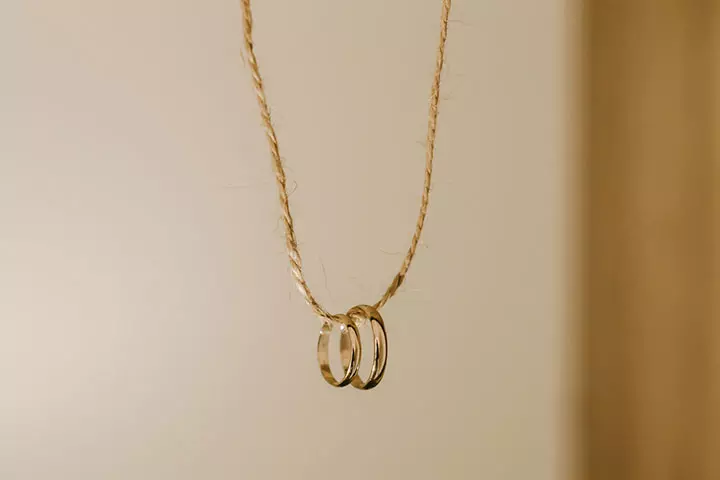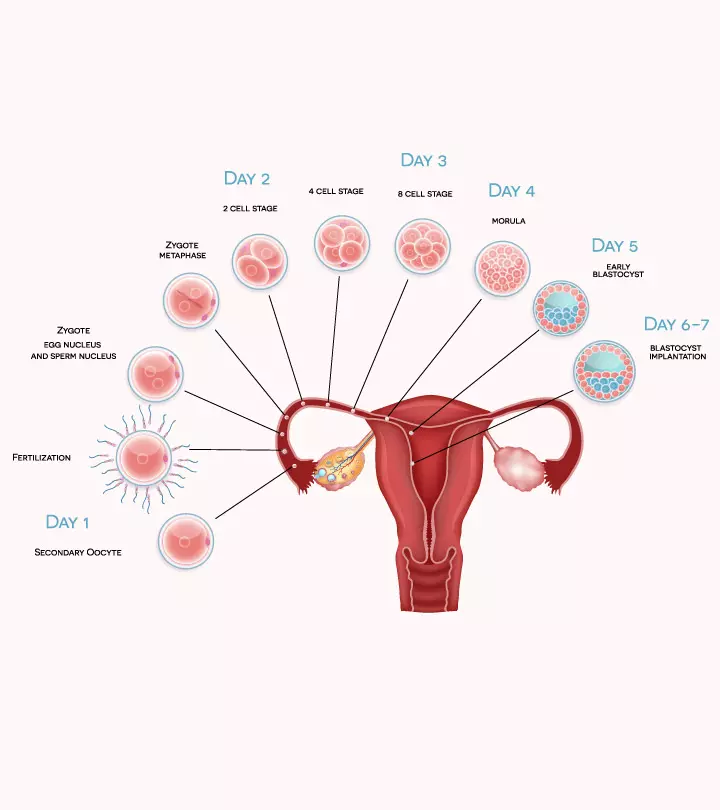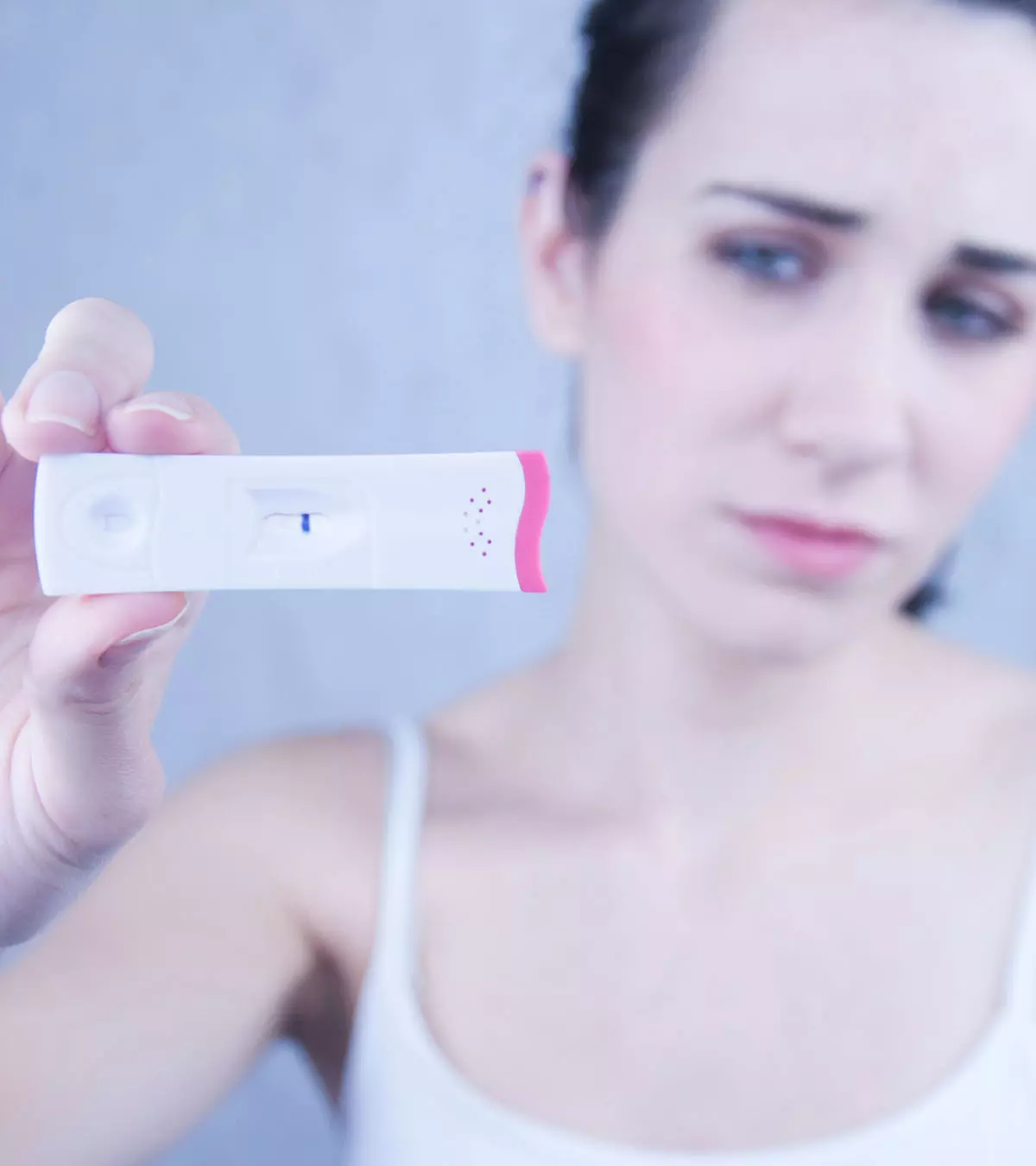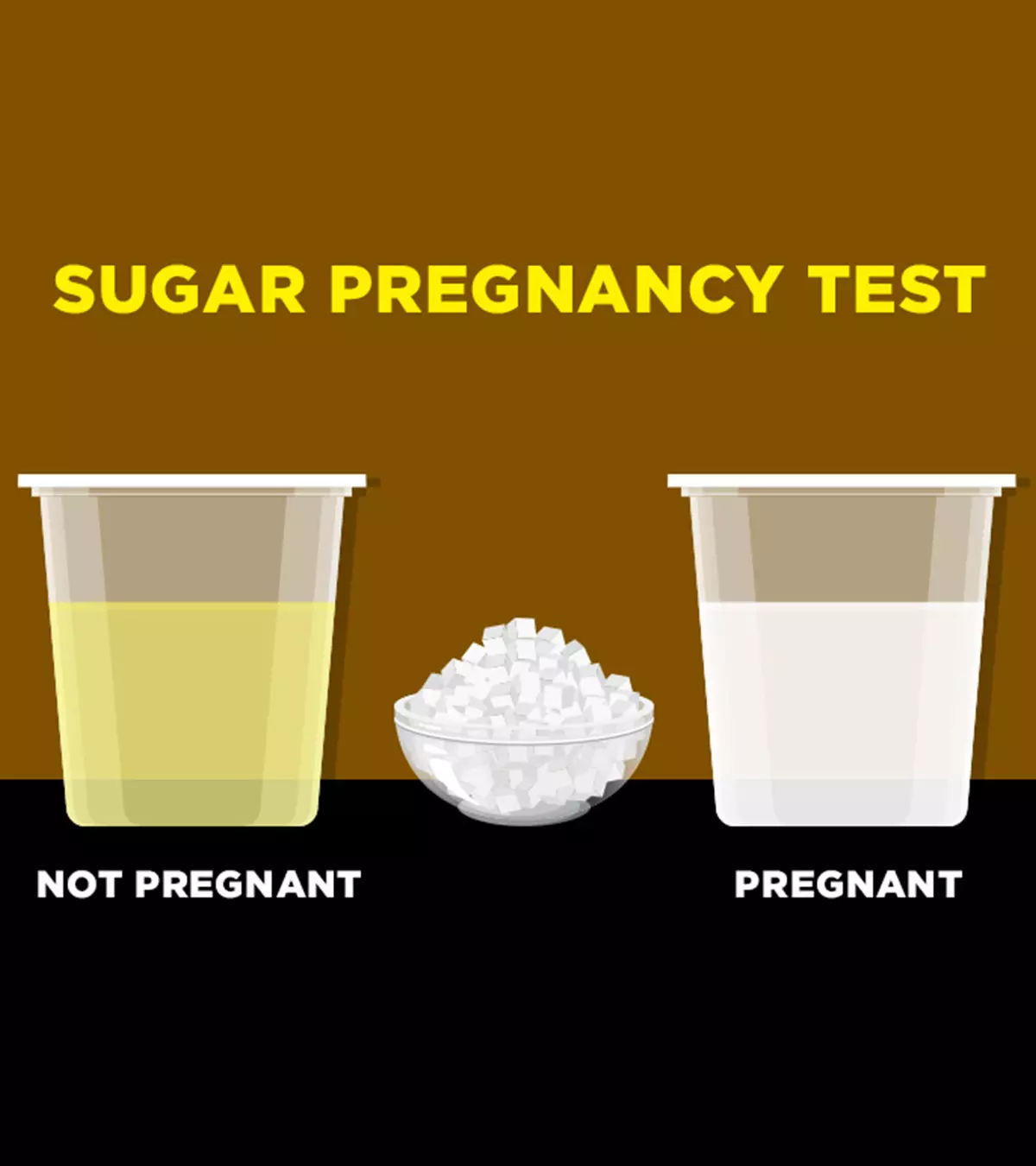
Image: Shutterstock
Different cultures have their traditional methods for predicting an unborn child’s gender. The ring gender test is a gender-prediction game requiring just a ring and a string. It is based on popular folklore, though its accuracy is widely debated.

Read on to know how to conduct this test and interpret the results. However, note that this technique is not scientifically proven, and its accuracy cannot be guaranteed.
Key Pointers
- The ring gender test is a traditional or folklore-based gender prediction game that uses a ring and a string suspended over a pregnant belly.
- The test results are interpreted by observing the free oscillation and direction of movement. A to-and-fro trend indicates a boy, while circular movement means a girl.
- The movement of the string may be influenced by subconscious thoughts, movements and other environmental factors, and as such, it is not scientifically proven to be an effective gender predictor.
- While such tests are non-threatening and fun, it is best to consult a doctor and perform an ultrasound to ensure proper baby growth and development.
Cultural Significance Of The Ring Gender Test
The ring gender test is one of the many traditional methods used to predict a baby’s gender around the world. It is believed to have originated from European folklore. Even today, it is regularly employed as a fun way to predict gender, especially during baby showers. Several cultures have their unique gender prediction folklore and customs. Some of these traditional tests depend on the shape of the belly or the breast changes, for instance, there is an old wives’ tale that if your left breasts seem bigger, it might be a boy, or if your right breasts feel bigger, it might be a girl. A few more of these tests include the Chinese lunar calendar, where the age of the mother and the month when she conceived is used to determine the baby’s gender, and Mayan Gender Prediction, where the year the woman conceived and her age is looked at to determine baby’s gender (1).
While all these methods have been present in different cultures, there is no scientific evidence for these tests, which is why they are considered unreliable. Thus, you can probably use these methods as fun at your baby shower and other times.
Evelyn, a mother of four and a blogger, cites a few traditional gender prediction tests, including the Chinese Calender Prediction Test, Older Sibling’s Hairline Test, and more that she tried during her pregnancy. She shares, “Since I couldn’t rely on my doctor to tell me what gender my baby was, I had to take maternal matters into my own hands. What a perfect opportunity to test out a few gender prediction tests and old wives’ tales.” She further shares the inconsistent result she received from these tests, saying, “To summarize my official and unquestionable scientific research: Out of 8 gender prediction tests, tales, and ‘tuitions, six gender prediction tests predict GIRL and 2 predict BOY. In short, the previously detailed research leads us to the conclusion that a baby girl is in our near future.
P.S. I had another ultrasound today…It’s a GIRL (i)! ”
How To Do The Ring Gender Test?

You may try the wedding ring test at your baby shower, during your gender reveal party in private, or with your family.
- Tie your wedding ring to a piece of thread.
- Hold the thread over your belly as you lie on the bed.
- You may also ask your partner to dangle it over your belly.
- Allow the string to move without any external interference.
There are also a few alternative ways to do the ring on a string test. Those variations include:
- Use a strand of hair in place of thread.
- Use a needle in place of a wedding ring.
- Hold the ring over the wrist instead of the belly.
- Place the threaded ring in your palm for some time, and then raise the string so that it swings over the palm.
- Hold the string in front of the belly while you are standing.
You may also use an engagement ring or promise ring instead of a wedding ring.
 Did you know?
Did you know?Interpreting the results
Here is how to interpret the result of this pregnancy test.
- If the ring moves in a circle, you are said to be carrying a girl.
- If it moves to and fro, you are said to be having a boy.
How Accurate Is The Ring Test For Gender Prediction?

Florida-based physician Dr. Matthew Casavant says, “It is crucial to note that the ring gender test is a fun old wives’ tale with no scientific basis. The test involves dangling a ring tied to a string over a pregnant woman’s belly. The direction of the ring’s swing is entirely coincidental and does not provide reliable information about the baby’s gender.”
If you are looking for scientifically proven techniques such as genetic testing methods, sex determination tests, or gender predictors, the ring test is not one of them. It is part of folklore, and how it works is not known. For scientific and more accurate determination of gender, you can go for ultrasound tests or even genetic testing.
An anonymous mom and blogger says, “There is an old wives tale that if a ring on a string is dangled over a pregnant woman’s stomach, the ring will reveal whether she will give birth to a boy or a girl. The ring test held true for Ari and Emilie (her children). We did the test on Angela (another woman) a few weeks ago, and it predicted a boy; sure enough, Angela’s ultrasound confirmed she is having a boy (ii).”
Practically speaking, this test might be influenced by the subconscious working of your mind and ideomotor movements. The ideomotor movements are subtle muscle movements that occur without any conscious effort. Dr William B. Carpenter introduced the phrase “ideomotor action,” which means muscle movements responding to outside influences (2).
 Trivia
TriviaAre There Any Studies On Ring Tests For Gender Prediction?
A study performed by Johns Hopkins of Bloomberg School of Public Health in 1999 found that amongst the 104 women who used any of the gender prediction methods, such as the ring gender test, only 55% guessed it right, suggesting that using these methods is similar to taking a wild guess (3).
Ring On A String: The Safe Gender Prediction Test

Safety is of utmost importance during pregnancy. Eagerness to know the gender of the baby can sometimes lead to unwise decisions. However, the string test is safe and simple, although its accuracy cannot be guaranteed.
A better option is a pregnancy ultrasound procedure, which is usually performed around the 18th to 22nd week as a part of regular prenatal check-ups. It could help determine the biological sex of the baby (4). Several studies showed the accuracy of pregnancy ultrasound for fetal gender to be around 90-95% for males and nearly 100% for females between the 16th and 40th weeks of gestation (5) (6). Genetic tests, like cell-free DNA screening (NIPT), are another scientific method to determine fetal gender. It requires the mother’s blood to analyze the cell-free fetal DNA in her blood. This optional test is usually recommended by the healthcare provider after 10 weeks of gestation to rule out genetic conditions, especially in high-risk pregnancies, and is not done for fetal sex determination in general (7).
It is also important to note that your doctor will not tell you about the gender of your baby if prenatal gender determination is illegal in your country.
Frequently Asked Questions
1. When can I do the ring test?
There is no particular specification as to when the ring test can be performed. However, you can learn the sex of your child through this sex-predication test in early or mid-pregnancy.
2. How do ring tests predict if I’m having twins or not?
According to the anecdotal evidence, if the ring goes dangling and pauses for a brief second and then immediately goes again, it might predict multiple babies.
3. Can the ring gender test substitute medical methods of determining gender?
The ring gender test is not a reliable substitute for medically proven methods to determine gender. It lacks scientific evidence and accuracy, leading to potential misinterpretations. It’s crucial to consult medical professionals and use established, scientifically validated methods for accurate gender determination.
4. Are there any cultural or societal implications of relying on the ring gender test?
The reliance on the ring gender test may have cultural and societal implications. Solely relying on this test to determine a baby’s gender may result in misunderstandings, misinterpretations, and gender biases. Therefore, it’s vital to approach these tests cautiously, considering the wider cultural and societal beliefs about gender.
5. Can I take the ring gender test at home?
Yes, the ring gender test can be conducted at home, but it should be trusted only to the extent of fun and guessing games. Acknowledging the lack of scientific backing and accuracy for this method is crucial. Hence, consulting medical experts for precise gender determination is advisable.
The ring gender test is one of the traditional methods for predicting the gender identity of the unborn fetus using a thread and a ring. Although the use of such folklore of gender prediction has been around for a long time, not many scientific studies prove the efficiency of these methods. Experts suggest that performing such tests is almost equal to taking a wild guess about the baby’s gender. However, they can be performed for fun. Therefore, it is advisable to consult the doctor and examine through proven prenatal testing procedures for the correct result.
Disclaimer: Gender-prediction methods are only for fun and do not replace medical examinations. MomJunction believes in gender equality; we do not support or encourage gender determination nor entertain any queries on finding the gender of the baby.
Infographic: How To Do A Ring Gender Test
The Ring Gender Test is a traditional, simple, and non-invasive method for predicting the gender of an unborn baby. You could try this method for fun with your partner and the family during pregnancy. In the infographic below, explore the step-by-step guide for this popular method of gender prediction.
Some thing wrong with infographic shortcode. please verify shortcode syntax
Illustration: What Is Ring Gender Test? How Does It Work? And Its Accuracy

Image: Dalle E/MomJunction Design Team
Calm your curiosity about the ring gender test as you take a look at this video, before you decide to give it a try as a fun activity.
Personal Experience: Source
MomJunction articles include first-hand experiences to provide you with better insights through real-life narratives. Here are the sources of personal accounts referenced in this article.
i. What the HCG is in There?!;https://hangingbyasilverlining.blogspot.com/2010/10/getting-in-touch-with-my-inner-mystery.html
ii. A ring. A string. A mystery.;
https://latentchestnut.blogspot.com/2009/11/ring-string-mystery.html
References
- Pregnant? How to Guess if You’re having a Boy or a Girl; RMC Health System
- Sasha Ondobaka and Harold Bekkering; Hierarchy of Idea-Guided Action and Perception-Guided Movement; Front Psychol. (2012)
- Educated Moms Better at Predicting Baby’s Sex; Johns Hopkins Bloomberg School of Public Health (1999)
- Common Prenatal Tests & Screenings; UC San Diego Health
- Michael McFadzen et al.; Maternal Intuition of Fetal Gender; Journal of patient-centered research and reviews (2017)
- Razieh Behzad Mehr et al.; Accuracy of Ultrasonography in Fetal Gender Determination in 11 to 14 Week of Gestational Age; The Official Journal of Zahedan University of Medical Sciences (2025)
- Non-invasive prenatal testing (NIPT) for foetal sex determination; Norwegian Institute of Public Health
- Knowing Baby’s Sex Before Birth: Some Pros and Cons of Gender Reveal; American Pregnancy Association
Community Experiences
Join the conversation and become a part of our nurturing community! Share your stories, experiences, and insights to connect with fellow parents.
Read full bio of Dr. Umera Zakiahmed Saiyed
- Dr. Matthew Casavant is the founding physician of South Lake OB/GYN & Advanced Surgery. He received his medical degree from Nova Southeastern University in South Florida and completed his residency as an Ob/Gyn at St. Vincent’s /Mercy Hospital in Toledo, OH. Dr. Casavant also holds a BS degree in Micro and Molecular Biology.
 Dr. Matthew Casavant is the founding physician of South Lake OB/GYN & Advanced Surgery. He received his medical degree from Nova Southeastern University in South Florida and completed his residency as an Ob/Gyn at St. Vincent’s /Mercy Hospital in Toledo, OH. Dr. Casavant also holds a BS degree in Micro and Molecular Biology.
Dr. Matthew Casavant is the founding physician of South Lake OB/GYN & Advanced Surgery. He received his medical degree from Nova Southeastern University in South Florida and completed his residency as an Ob/Gyn at St. Vincent’s /Mercy Hospital in Toledo, OH. Dr. Casavant also holds a BS degree in Micro and Molecular Biology.
Read full bio of Rebecca Malachi
Read full bio of Swati Patwal
Read full bio of Aneesha Amonz

















